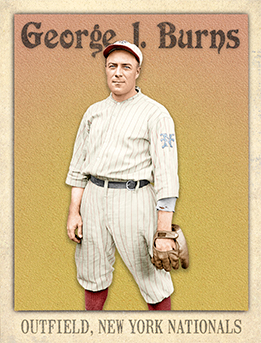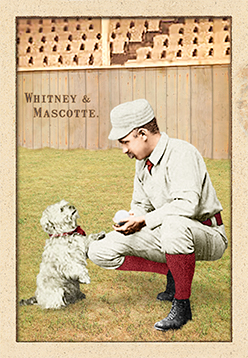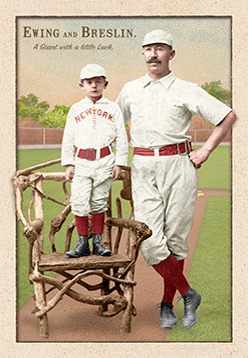
- Series: Diamond Heads '15
- City: New York
- Team: Giants
- League: National League
George Joseph Burns (1889-1966) was dubbed by his teammates “Silent George” for his reserved, soft-spoken manner. He might as well have been named “Anonymous George” as one of the greatest outfielders of his generation of whom few remember today. He retired holding records for leading the National League in runs scored five times, a Giants' club single-season record for steals (62) that still stands, and top-ten ranking in games played and games in the outfield in MLB. The Utica native debuted with McGraw's crew in 1911 and George quickly found a home in left at the Polo Grounds, mastering its odd angles and even conquering the dazzling afternoon glares, prompting scribes to dub the area Burnsville. He was one of the first to don sunglasses and his mates later described him as “the 'greatest sun fielder' in the history of the game.” Only Rogers Hornsby exceeded George's total bases in 1917 and it wasn't till Willie Mays 53 years later in 1972 that his career stolen base record for the Giants would be eclipsed. His last hurrah in NY was the 1921 Series. The team hadn't won in October since 1905 and George hadn't performed well in his previous attempts at post-season glory. But '21 proved triumphant for Burns and his team as they beat the Yankees in the first Series between teams sharing the same home field. Babe Ruth had been phenomenal in the regular season but was hurt during the post-season and George got to wear the laurel wreath.
- A renowned amateur boxer and wrestler, the diminutive Burns never backed down from invitations to grapple with his much more physically formidable teammate Jim Thorpe
- Growing up in his father's pool hall, Burns was a world-class pool player, but teammates wouldn't play with him unless he agreed to play left-handed
- McGraw traded Burns to the Reds two months after the '21 World Series for Heinie Groh, but the speedy Burns wasn't through. He set an NL record with his 28th steal of home in 1922
- In fifteen ML seasons, Burns' 2,077 hits produced a .287 career average and only Musial and Hornsby equaled his feat of leading the NL five-times in runs record

- Series: 1880s: Diamond Duos
- City: New York
- Team: Giants
- League: National League
Art Whitney:
Arthur Wilson Whitney (1858-1943). Art played 3rd base for 8 different teams over 11 major league seasons. A below average hitter, his best year may have been 1886 with the Pittsburgh Alleghenys when he compiled 122 hits, 13 doubles, 4 triples, 15 steals & 70 runs with a light .239 batting average.
- 2x World Series Champion with the New York Giants: 1888 & 1889
- Although I haven't quite figured it all out, it appears Whitney was part of a fairly distinguished baseball family. His brother Frank played for the Boston Red Stockings in 1876; Charles Whitney, who played minor league ball from 1879 to 1889, was also likely Art's brother; and research suggests that 10 year major league veteran Grasshopper Jim Whitney may have been a cousin.
Mascotte:
This dog's name and relationship to Art Whitney and/or the New York Giants has been lost to history. I have no evidence that this dog ever served as the team's mascot, but she does appear to be wearing a handkerchief in the team's colors. The Giants (Buck Ewing in particular) were notoriously superstitious about their mascots. At one time or another between 1884 and 1890, the Giants "employed" at least five children: Masters Boldt, Bretsie, Preston, Breslin and an unidentified "colored boy," a yellow mongrel dog who was eventually captured by animal control and euthanized, and a toy rubber dog that barked when squeezed.
Despite the mystery surrounding this dog, her presence and photogenic posing created what REA has described as "one of the most unusual and memorable images to ever appear on a baseball card." It has been suggested that this image was staged and intended by the Goodwin photographers to represent a sort of comedic complex irony. Between the minor and major leagues, Art Whitney played for 12 different teams over 17 professional seasons and twice sued his team in contractual disputes. Even in an era when few players stayed with any one team for more than a year or two, Whitney's lack of loyalty was possibly renowned and cast into stark contrast in this photo by the adoring attention he is being given by man's best friend, the ever-loyal dog.
Whether the meeting between the two was devised or a genuine moment in time caught by a Goodwin photographer, I think the image's appeal is due to something simple we can all relate to: it's fun.
In fact, this is perhaps the image that most directly inspired the idea behind the Ars Longa 1880s series. In the nascent stages of my work, when this was all but an amorphous and rudimentary idea, I saw this image and thought how fun it would be to colorize it. Three and a half years and nearly 750 cards later, here it is.
Auction History
Cartophilia
Old Judge Pose: 499-1
- Series: Pioneer Portraits II: 1875-1899
- City: New York
- Team: Giants
- League: National League
- Hall: National Baseball Hall of Fame
Smiling Tim, Sir Timothy (1857-1933). A dominant pitcher for 5 teams over 14 seasons, Keefe’s 1st season was the last in which pitchers threw from 45′ & his last season was the 1st in which they threw from 60’6″. In an extraordinary career, Keefe won 20+ gms 7x; 30+ gms 6x; 40+ gms 2x; 200+ Ks 6x; 300+ Ks 2x; & posted lowest ERA in history: 0.86 in 1880.
- Won Triple Crown: 1888
- ERA Champ: ’80, ’85, ’88
- 342 career Wins
- Elected to Hall of Fame: 1964

- Series: 1880s: Diamond Duos
- City: New York
- Team: Giants
- League: National League
- Hall: National Baseball Hall of Fame
Buck Ewing:
William Ewing (1859-1906) was the premier catcher of the 19th century, honored for decades after his early death as even, perhaps, the greatest player of all time. A scourge at bat, Buck hit over .300 ten times. He played behind the plate with courage and style, crouching close to the hitter so as to shave precious seconds off his inerrant throws. Ewing had debuted with the remarkable Troy Trojans in 1880 and joined four future Hall-of-Famers in moving to NYC in ‘83. The sturdy catcher may have been the primary inspiration for Jim Mutrie’s “my Giants!” exclamation that led to the new identity of the Gothams. An arm injury on a raw spring day curtailed his tenure behind the plate from 1891 on. Such a magnetic figure couldn’t escape the turmoil of the Players’ League controversies and Ewing was sometimes pilloried for lax effort. Despite such caviling, Ewing left as indelible a mark on the game’s first century as anyone. Upon his induction to Cooperstown (among the first six of the “pre-modern” era), he was hailed by Connie Mack as the greatest catcher he had seen and he had seen most.
- “Buck” was a derivative of “Buckingham,” bestowed on the budding star by an admiring scribe who wanted to add gravitas to the youngster’s reputation
- Played all nine positions and managed 3 different teams over 7 seasons
- Was the first catcher elected to the Hall of Fame; and the second 19th century player elected (after Cap Anson)
- Elected to Hall of Fame: 1939
Willie Breslin:
Master William Breslin was one in a line of NY Giants’ mascots in the 1880s, primarily due to HOF catcher Buck Ewing’s love of “hoodoos.” Superstition is still alive and well in baseball and goes back to its roots. In the old days it wasn’t rally monkeys, tomahawks or Phanatics–it was young boys recruited from the mean streets by ball players desperate for an edge. Lads such as “masters” Betsie and Preston prowled the NY dugout in 1886, preceded by an unknown “colored boy” that year. Any charm could do, though. Ewing seized on a yellow mutt, a ring-tailed monkey named “Mose,” or a toy barking dog. But no mascot seems to have gained the popularity and fame of Willie Breslin. He wasn’t the first to be given an Old Judge card (that was Willie Hahm in 1887), but he is the only one to have his own card as well as a famous pose with Ewing in a photo taken in 1884 and used on the OJ series of 1889. One of Buck’s proteges was Fred Boldt, a Chicago waif the team picked up on the road. Back in NY, young Fred ran up an account at a diner near the Polo Grounds and absconded with Cannonball Titcomb’s shoes.
- The Breslin Old Judge cards have become highly prized
- Sadly, biographical data for Willie and his cohorts is lacking. We trust he turned out better than young Boldt
Auction History
Cartophilia
Old Judge Pose: 149-11
- Series: Beginnings: 1880's
- City: New York
- Team: Giants
- League: National League
Michael Joseph Tiernan (1867-1918) overcame early miscues (a still-MLB-record 5 errors in a game & giving up a 10-run 10th inning in relief) to become a model of stability and decorum for the NY Giants, playing exclusively for them his entire 13-yr career. His bat trumped all else. “Silent Mike” was 4th in 19th Century HRs and batted .311 lifetime.
- Tiernan’s bat was key to the NY triumphs in the ’88-89 “world series”
- His outstanding year in ’91 silenced any animosity felt by returning teammates who had formed the ill-fated Players’ League




